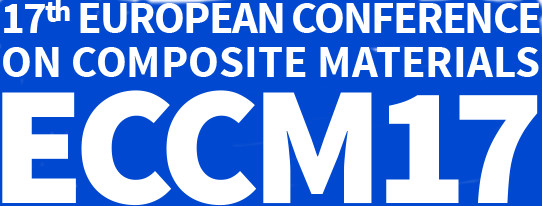

App-Einstellungen:
NON-DESTRUCTIVE EVALUATION OF PREFORM INJECTABILITY AND COMPRESSIBILITY FOR QUALITY ASSESSMENT IN A PRODUCTION ENVIRONMENT
Tino Hermann (University of Auckland) Simon Bickerton (University of Auckland) S. van Oosterom (University of Auckland) G. Lamb (University of Auckland) Thomas Henke (BMW Group)
An innovative non-destructive method is presented for assessment of the compressibility and injectability of textiles, stacks, and preforms. Fast non-destructive tests are required to support the industrialisation of FRP manufacture.
ON THE THERMAL BEHAVIOR OF THERMOPLASTIC LAMINATES DURING TRANSFER – A NOVEL WIND-TUNNEL APPROACH
Daniel Kugele (Karlsruhe Institute of Technology) Julius Rausch (Audi AG) Jochen Kriegseis (Karlsruhe Institute of Technology) Kai Gündisch (Karlsruhe Institute of Technology) Luise Kärger (Karlsruhe Institute of Technology) Frank Henning (Karlsruhe Institute of Technology)
The transfer step of the molten laminates has an important influence on the temperature distribution of the laminates and is therefore investigated in the present study.
ONE STEP TO COMPARABLE OFF-PLANE PERMEABILITY RESULTS – AN IMPROVED MEASURING METHOD FOR TRANSVERSE PERMEABILITY AND COMPACTION BEHAVIOR OF TEXTILE FIBER MATERIALS
Robert Graupner (Fraunhofer ICT) Klaus Drechsler (Technical University of Munich / Institute for Carbon Composites)
For off-plane permeability measurement methods a homogeneous FVC is assumed. The investigation shows a contrary result when metal structures with holes are used. In consequence the permeability values are assumed to dependent on the used equipment.
ROBUST OPTICAL 2D PERMEABILITY CHARACTERIZATION OF REINFORCING FABRICS
Ewald Fauster (Montanuniversitaet Leoben) Harald Grössing (Montanuniversitaet Leoben) Ralf Schledjewski (Montanuniversitaet Leoben) K. Fellner (Polymer Competence Center Leoben GmbH)
A new approach for compensating glass plate deformation in optical 2D permeability characterization involving a combination of image and data processing steps with structural FEM simulation in a fully automated evaluation procedure.
APPROACH TO CHARACTERIZE THE PROCESS DEPENDING MECHANICAL PROPERTIES OF UD-BRAIDED CFRP LAMINATES
Christian Metzner (Airbus Group Innovations) Daniel Gizik (Airbus Group Innovations) Jörg Kaufmann (University of Chemnitz) Lothar Kroll (University of Chemnitz)
In this study a methodic for the characterization of the process depending mechanical properties of unidirectional braided CFRP laminates is presented.
ASSESSMENT OF COMPOSITES REINFORCED WITH INNOVATIVE 3D WOVEN HOLLOW FABRICS
Ruben Geerinck (University Ghent) Ives De Baere (UGent, Department of Materials Science and Engineering) Geert De Clercq (UGent, Department of Materials Science and Engineering) Jan Ivens (KU Leuven) Joris Degrieck (Ghent University)
The development and production of complex 3D woven fabrics and their possibilities within composites with respect to production and properties are explored.
EXPERIMENTAL STUDY OF THE TOW BUCKLING DEFECT. TOWARDS THE DETERMINATION OF A MULTI-FACTOR APPEARANCE CRITERION FOR THE FORMING PROCESS SIMULATION.
Pierre Ouagne (ENI Tarbes/ Université Orléans) Christophe Tephany (Université Orléans) Jean Gillibert (Université Orléans) Damien Soulat (ENSAIT)
This paper deals with the measurement by fringe interferometry of the tow buckle defect appearing during complex shape forming of fabric. The mechanisms conditioning the appearance and growth of the defect are related to an occurrence criterion.
INVESTIGATION ON CREATION OF FIBROUS RINGS AND THEIR INFLUENCE ON THE BRAIDED PREFORM QUALITY
Andreas Mierzwa (Technical University of Munich / Institute for Carbon Composites) Christoph Ebel (Technical University of Munich / Institute for Carbon Composites) Tobias Harbers (Technical University of Munich / Institute for Carbon Composites) Klaus Drechsler (Technical University of Munich / Institute for Carbon Composites)
During braiding of carbon fiber yarns specific defects may occur. One common defect is the fibrous ring. This paper deals with the origin of fibrous rings and its effects on the braided preform quality.
NEW TEXTILE TECHNOLOGIES FOR FRP-APPLICATIONS
Günther Thielemann (Sächsisches Textilforschungsinstitut e.V.) Reinhard Helbig (STFI e.V.) Martin Braun (STFI e.V.)
This paper presents three developments for efficient, waste and time reduced manufacturing processes for semi-finished fibre-reinforced products.
SPREADING OF HEAVY TOW CARBON FIBERS FOR THE USE IN AIRCRAFT STRUCTURES
Daniel Gizik (Airbus Group Innovations) Christian Metzner (Airbus Group Innovations) Christian Weimer (Airbus Group Innovations) Peter Middendorf (University of Stuttgart)
In this paper, a study on the process parameters of a commercial spreading machine was conducted. Several heavy tow carbon fibers were tested, compared and their quality regarding the spreading process was evaluated.
